|
The main theme of the Union Budget 2012-13 was expected to be containing the high fiscal deficit. Accordingly, the hike in indirect taxes and service tax were expected with control expenditure. The Reserve Bank of India was also urging for greater fiscal co-ordination to help it keep check on inflation and cut interest rates to support economic growth. The Union Budget has aimed to reduce fiscal deficit to 5.1% during 2012-13 and further trim it to 4.5% in 2013-14 and 3.9% in 2014-15. The fiscal target for 2012-13 was mostly in line with market expectations. However, the Finance Minister announced various fiscal reforms, but the timing of Direct Tax Code (DTC), Foods & Service Tax (GST) as well as direct subsidy disbursal remains the uncertain. Meanwhile, it is slated to miss the target to reduce fiscal deficit to 3.0% by 2013-14 as set by Thirteenth Finance Commission.
The year 2011-12 was one of challenges for fiscal management. Due to the slower economic growth, direct tax collection fell short by Rs 32,000 crore of the Budget Estimates. At the same time, the Government absorbed duty reduction in petroleum sector with annual revenue loss of Rs 49,000 crore. The Government had to incur higher expenditure on petroleum and fertiliser subsidy to insulate the people from the rising prices. The combined effect of lower tax and disinvestment receipts and higher expenditure, mainly on account of subsidies, has pushed the fiscal deficit to 5.9% of GDP in the Revised Estimates for 2011-12.
The reduction in fiscal deficit to 5.1% during 2012-13 would be partly achieved by hiking excise and service taxes from 10% to 12%, and shifting from positive to negative list for service tax levy. The tax revenue growth would be supported with expected improvement in growth during next two fiscals. Also, as against mere Rs 15493 crore raised in FY 2011-12, from divestment of stake in PSUs, the budgeted estimates expect nearly 94% spike there from to Rs 30000 crore during 2012-13. Even sizeable portion of Rs 15493 crore was achieved only by selling one PSU stake to other, and markets are yet to become buoyant any time sooner.
Besides achieving revenue and disinvestments targets, the achievement of fiscal deficit target critically hinges on how the government is going to reign in subsidies, which surged from budgeted estimates of Rs 143570 crore to revised estimates of Rs 216297 crore! Against such gross shooting up of subsidies, now the government expects only 12% fall in subsidies to Rs 190015 crore (BE) for FY 2012-13! This, at a time when the global crude oil prices are sizzling and as India increases imports to satisfy the domestic fertilizer demand!. Also, the success of subsidies consolidation would critically depend on the implementation of subsidies reforms.
Market loans are set to be about 10% higher at R 479000 crore (BE) for FY 2012-13, up from Rs 436414 (RE) for FY 2011-12, which is significantly higher than Rs 343000 budgeted originally! However, the government continues to finance higher portion of fiscal deficit ie above 90% with market borrowing through issuance of dated securities. With higher redemption of g-sec at Rs 90616 crore for 2012-13, the gross supplies of g-sec for 2012-13 rises to 5.69 lakh crore, showing 11.7% rise over previous year. The expectations for overall interest rate cuts from RBI for 2012-13 have eased, after RBI sighted upside risks to inflation. Meanwhile, the relatively higher supplies of g-sec, Rs 12-18000 crore per week, would continue to weigh up on yields during 2012-13.
One of the primary drivers of the current account deficit has been the growth of almost 50% in imports of gold and other precious metals in the first three quarters of 2011-12. However, the Finance Minister has increased the custom duty on standard gold bars; gold coins of purity exceeding 99.5% and platinum from 2% to 4%, reduce the growth of unproductive imports.
There is optimism built into the budget in terms of expecting higher receipts, and under-estimating the expenditure. This is precisely what the government did last year too, which landed it in higher fiscal deficit of 5.9% for FY 2011-12 (Revised) from estimated / budgeted 4.6%! On the positive side, the global fertilizer prices are easing, and if this trend continues, the government may be able to contain fertilizer subsidy. Also, Government has targeted to reduce subsidies bill as percentage of GDP to 1.75% over next three years. Similarly, the telecom spectrum is expected garner non-tax revenue of Rs 50000 crore during 2013-14 to 2014-15, which would ease fiscal deficit.
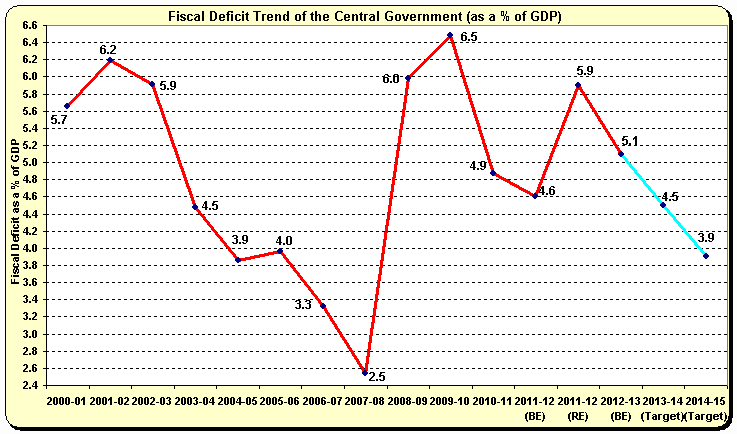
Five objectives
1. Focus on domestic demand driven growth recovery;
2. Create conditions for rapid revival of high growth in private investment;
3. Address supply bottlenecks in agriculture, energy and transport sectors, particularly in coal, power, national highways, railways and civil aviation;
4. Intervene decisively to address the problem of malnutrition especially in the 200 high-burden districts; and
5. Expedite coordinated implementation of decisions being taken to improve delivery systems, governance, and transparency; and address the problem of black money and corruption in public life.
Economic Outlook
- India's GDP growth in 2012-13 to be 7.6%, +/- 0.25%.
- Inflation to be lower next year.
- The current account deficit to be smaller, aided by improvement in domestic financial savings.
Fiscal Consolidation
- Fiscal balance deteriorated in 2011-12 due to slippage in direct tax revenue and increased subsidies.
- To reduce the expenditure on Central subsidies to 1.75% of GDP over the next three years
- For 2012-13, Rs 30,000 crore would be raised through disinvestment, keeping in view that at least 51% ownership and management control will remain with the Government.
Strengthening Investment Environment
- Introduce a new scheme called Rajiv Gandhi Equity Savings Scheme allowing for income tax deduction of 50% to new retail investors, who invest up to Rs 50,000 directly in equities and whose annual income is below Rs 10 lakh. The scheme will have a lock-in period of 3 years. The details will be announced in due course.
Capital Markets
- Allowing Qualified Foreign Investors (QFIs) to access Indian Corporate Bond market;
-Simplifying the process of issuing Initial Public Offers (IPOs), lowering their costs and helping companies reach more retail investors in small towns.
-Providing opportunities for wider shareholder participation in important decisions of the companies through electronic voting facilities
-Permitting two-way fungibility in Indian Depository Receipts
Capitalization of Banks and Financial Holding Company
- To provide Rs 15,888 crore for capitalization of Public Sector Banks, Regional Rural Banks and other financial institutions including NABARD.
- The Government is also examining the possibility of creating a financial holding company which will raise resources to meet the capital requirements of Public Sector Banks.
- Extend the scheme of capitalization of weak RRBs by another 2 years to enable all the States to contribute their share.
Infrastructure
Tax-free bonds issuance doubled to Rs 60000 crore in 2012-13. This includes Rs 10000 crore for NHAI, Rs 10000 crore for IRFC, Rs 10000 crore for IIFCL, Rs 5000 crore for HUDCO, Rs 5000 crore for National Housing Bank, Rs 5000 crore for SIDBI, Rs 5000 crore for ports and Rs 10000 crore for power sector.
Power and Coal
To allow External Commercial Borrowings (ECB) to part finance Rupee debt of existing power projects.
Transport: Roads and Civil Aviation
- Target of covering a length of 8,800 kms under NHDP next year. The allocation of the Ministry has been enhanced by 14% to Rs 25,360 crore in 2012-13.
- To encourage public private partnerships in road construction projects
- allow ECB for capital expenditure on the maintenance and operations of toll systems for roads and highways so long as they are a part of the original project.
- Permit ECB for working capital requirements of the airline industry for a period of one year, subject to a total ceiling of US Dollar 1 billion.
- Allow foreign airlines to participate up to 49% is under active consideration of the Government.
Housing sector
- Allow ECB for low cost affordable housing projects;
-Set up Credit Guarantee Trust Fund to ensure better flow of institutional credit for housing loans;
-Enhance provisions under Rural Housing Fund from Rs 3000 crore to Rs 4000 crore;
-Extend the scheme of interest subvention of 1% on housing loan up to Rs15 lakh where the cost of the house does not exceed Rs25 lakh for another year; and
-Enhance the limit of indirect finance under priority sector from
Rs 5 lakh to Rs 10 lakh.
Textiles
- Announced Rs 500 crore pilot scheme in the Twelfth Plan for promotion and application of Geo-textiles in the North East Region
- set up a powerloom mega cluster in Ichalkaranji in Maharashtra with a Budget allocation of Rs 70 crore.
Micro, Small and Medium Enterprises
Set up a Rs 5,000 crore India Opportunities Venture Fund with SIDBI.
Agriculture
Plan outlay for Agriculture is being increased by 18% to Rs 20,208 crore in 2012-13.
Outlay for Rashtriya Krishi Vikas Yojana (RKVY) increased from to Rs 9217 crore in 2012-13.
Allocation for Green Revolution to Eastern India raised from Rs 400 crore in 2011-12 to Rs1000 crore in 2012-13.
Rs 300 crore to Vidarbha Intensified Irrigation Development Programme
Raise the target for agricultural credit in 2012-13 to Rs 5,75,000 crore from Rs 475000 crore
- Interest subvention scheme for providing short term crop loans to farmers at 7% interest per annum will be continued in 2012-13. An additional subvention of 3% will be available to prompt paying farmers.
- Allocate Rs 10,000 crore to NABARD for refinancing the RRBs through this fund.
- Kisan Credit Card (KCC) scheme will be modified to make KCC a smart card which could be used at ATMs.
- Allocation for Accelerated Irrigation Benefit Programme (AIBP) in 2012-13 stepped up by 13% to Rs 14,242 crore.
Inclusion
In 2012-13, the allocation for Scheduled Castes Sub Plan (SCSP) increased by 18% Rs 37113 crore
Allocation for Tribal Sub Plan (TSP) raised by 17.6% to Rs 21710 crore
Integrated Child Development Services (ICDS) scheme is being strengthened and re-structured with 58% increase in allocation to Rs 15850 crore
Provide Rs 200 crore to enlarge the corpus of ‘Women's SHG's Development Fund' to Rs 300 crore.
Provide interest subvention to Women SHGs to avail loans up to Rs3 lakh at 7% per annum. Women SHGs that repay loans in time will get additional 3% subvention, reducing the effective rate to 4%.
Rural Development and Panchayati Raj
Allocation for rural drinking water and sanitation increased 27% to Rs 14000 crore
Allocation for Pradhan Mantri Gram Sadak Yojana (PMGSY) raised by 20% to Rs 24000 crore
To carry the Backward Regions Grant Fund scheme into the Twelfth Plan with an enhanced allocation of Rs12,040 crore in 2012-13
Enhance the allocation under Rural Infrastructure Development Fund (RIDF) to Rs 20000 crore.
Education and Health
Provided Rs 25555 crore, 21.7% higher over 2011-12, for Right to Education (RTE) Act - Sarva Shiksha Abhiyan (SSA)
Allocation to National Rural Health Mission (NRHM) raised from Rs 18115 crore in 2011-12 to Rs 20822 crore in 2012-13
Security
Provision of Rs 193407 crore has been made for Defence Services which include Rs 79579 crore for capital expenditure.
Tax Proposals
Direct Taxes
- Enhance the exemption limit for the general category of individual taxpayers from Rs1,80,000 to Rs2,00,000.
- Increased the upper limit of the 20% tax slab from Rs 8 lakh to Rs10 lakh
- Deduction of up to Rs10,000 for interest from savings bank accounts.
- Deduction of up to Rs5,000 for preventive health check-up.
- Senior citizens who do not have any income from business are proposed to be exempted from the payment of advance tax.
- No change in corporate tax
- Rate of withholding tax on interest payments on external commercial borrowings is proposed to be reduced from 20% to 5% for three years. These sectors are power; airlines; roads and bridges; ports and shipyards; affordable housing; fertilizer; and dams
- Continue to allow repatriation of dividends from foreign subsidiaries of Indian companies to India at a lower tax rate of 15% as against the tax rate of 30% for one more year i.e. up to 31 March 2013.
- Investment linked deduction of capital expenditure incurred in the following businesses is proposed to be provided at the enhanced rate of 150%, as against the current rate of 100%. Cold chain facility, Warehouses for storage of food grains, Hospitals, Fertilizers, Affordable housing
-To promote investment in research and development, it is proposed to extend the weighted deduction of 200% for R&D expenditure in an in-house facility beyond March 31, 2012 for a further period of five years.
- Provided weighted deduction of 150% on expenditure incurred for agri-extension services in order to facilitate growth in the agriculture sector.
- For SMEs, the turnover limit for compulsory tax audit of accounts as well as for presumptive taxation is proposed to be raised from Rs 60 lakh to Rs 1 crore.
- In order to reduce transaction costs in the capital markets, I propose reduction in Securities Transaction Tax (STT) by 20% (from 0.125% to 0.1%) on cash delivery transactions.
- I propose to introduce a General Anti Avoidance Rule (GAAR) in order to counter aggressive tax avoidance schemes, while ensuring that it is used only in appropriate cases, by enabling a review by a GAAR panel.
- Proposals on Direct Taxes are estimated to result in a net revenue loss of Rs 4500 crore for the year.
Indirect Taxes
Service Tax
- To tax all services except those in the negative list.
- Raise the service tax rate from 10% to 12%, with consequential changes in rates for services that have individual tax rates.
- Proposals from service tax are expected to yield an additional revenue of Rs 18660 crore.
Indirect taxes
- Raised the standard rate of excise duty from 10% to 12%, the merit rate from 5% to 6%, and the lower merit rate from 1% to 2%.
- the lower merit rate for coal, fertilizers, mobile phones and precious metal jewellery is being retained at 1%.
- No change is proposed in the peak rate of customs duty of 10% on non-agricultural goods. Barring a few individual items, the rates below the peak are also being retained.
- Proposals on Direct Taxes are estimated to result in a net revenue loss of Rs 4500 crore for the year.
- Proposals relating to Indirect Taxes are estimated to result in a net revenue gain of Rs 45940 crore, leaving a net gain of Rs 41440 crore in the Budget.
Outlook
| Union Budget 2012-13 at a Glance |
| Sr No. |
Particulars |
2010-2011 |
2011-2012 |
2011-2012 |
2012-2013 |
Var. (%) |
| Actual |
BE |
RE |
BE |
2011-12 |
2012-13 |
| 1 |
Revenue Receipts |
788471 |
789892 |
766989 |
935685 |
-2.7 |
22.0 |
| 2 |
Tax Revenue (net to centre) |
569869 |
664457 |
642252 |
771071 |
12.7 |
20.1 |
| 3 |
Non-Tax Revenue |
218602 |
125435 |
124737 |
164614 |
-42.9 |
32.0 |
| 4 |
Capital Receipts (5+6+7) |
408857 |
467837 |
551730 |
555241 |
34.9 |
0.6 |
| 5 |
Recoveries of Loans |
12420 |
15020 |
14258 |
11650 |
14.8 |
-18.3 |
| 6 |
Other Receipts |
22846 |
40000 |
15493 |
30000 |
-32.2 |
93.6 |
| 7 |
Borrowings and other liabilities |
373591 |
412817 |
521980 |
513590 |
39.7 |
-1.6 |
| 8 |
Total Receipts (1+4) |
1197328 |
1257729 |
1318720 |
1490925 |
10.1 |
13.1 |
| 9 |
Non-Plan Expenditure |
818299 |
816182 |
892116 |
969900 |
9.0 |
8.7 |
| 10 |
On Revenue Account |
726491 |
733558 |
815740 |
865596 |
12.3 |
6.1 |
|
of which, |
|
|
|
|
|
|
| 11 |
Interest Payments |
234022 |
267986 |
275618 |
319759 |
17.8 |
16.0 |
| 12 |
On Capital Account |
91808 |
82624 |
76376 |
104304 |
-16.8 |
36.6 |
| 13 |
Plan Expenditure |
379029 |
441547 |
426604 |
521025 |
12.6 |
22.1 |
| 14 |
On Revenue Account |
314232 |
363604 |
346201 |
420513 |
10.2 |
21.5 |
| 15 |
On Capital Account |
64797 |
77943 |
80404 |
100512 |
24.1 |
25.0 |
| 16 |
Total Expenditure (9+13) |
1197328 |
1257729 |
1318720 |
1490925 |
10.1 |
13.1 |
| 17 |
Revenue Expenditure (10+14) |
1040723 |
1097162 |
1161940 |
1286109 |
11.6 |
10.7 |
| 18 |
-- creation of Capital Assets |
87487 |
146853 |
137505 |
164672 |
57.2 |
19.8 |
| 19 |
Capital Expenditure (12+15) |
156605 |
160567 |
156780 |
204816 |
0.1 |
30.6 |
| 20 |
Revenue Deficit (17-1) |
252252 |
307270 |
394951 |
350424 |
56.6 |
-11.3 |
|
|
-3.3 |
-3.4 |
-4.4 |
-3.4 |
|
|
| 21 |
Effective Revenue Deficit (20-18) |
164765 |
160417 |
257446 |
185752 |
56.3 |
-27.8 |
|
|
-2.1 |
-1.8 |
-2.9 |
-1.8 |
|
|
| 22 |
Fiscal Deficit {16-(1+5+6)} |
373591 |
412817 |
521980 |
513590 |
39.7 |
-1.6 |
|
|
-4.9 |
-4.6 |
-5.9 |
-5.1 |
|
|
| 23 |
Primary Deficit (22-11) |
139569 |
144831 |
246362 |
193831 |
76.5 |
-21.3 |
|
|
-1.8 |
-1.6 |
-2.8 |
-1.9 |
|
|
Figures in Rs crore;
Source: Union Budget 2012-13 |
| Variation in Actual and Estimated Fiscal Deficit |
|
Budget Estimate |
Revised Estimate |
Actual |
| 2000-01 |
111275 |
111972 |
118816 |
| 2001-02 |
116314 |
131721 |
140955 |
| 2002-03 |
135524 |
145466 |
151144 |
| 2003-04 |
153637 |
132103 |
123272 |
| 2004-05 |
137407 |
139231 |
125202 |
| 2005-06 |
151144 |
146175 |
146435 |
| 2006-07 |
148686 |
152328 |
142573 |
| 2007-08 |
150948 |
143653 |
126912 |
| 2008-09 |
133287 |
326515 |
336992 |
| 2009-10 |
400996 |
414041 |
418482 |
| 2010-11 |
381408 |
400998 |
373591 |
| 2011-12 |
412817 |
521980 |
|
| 2012-13 |
513590 |
|
|
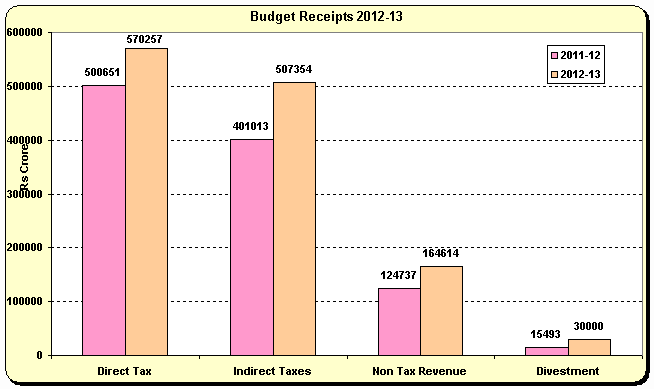
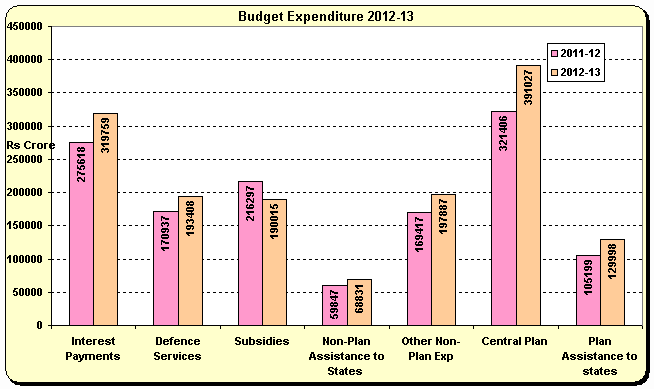
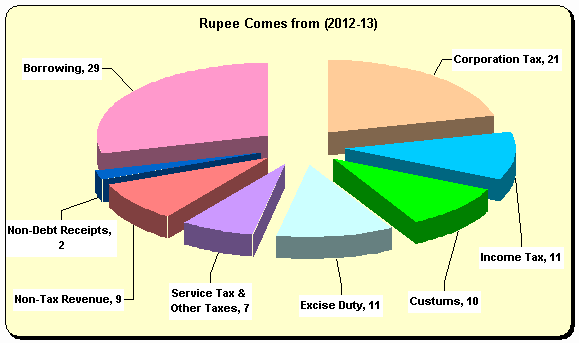
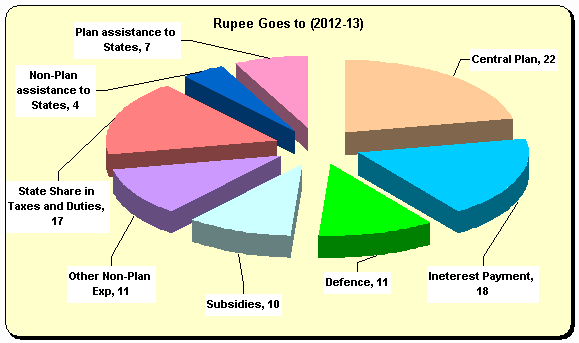
|